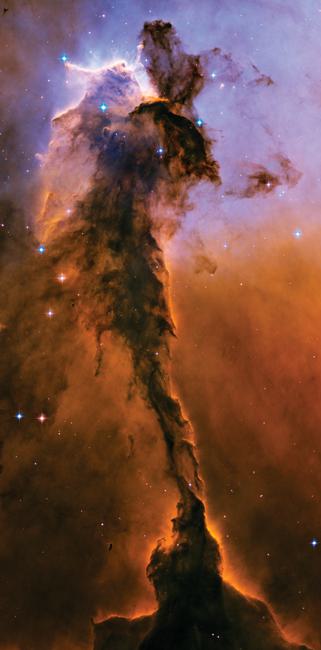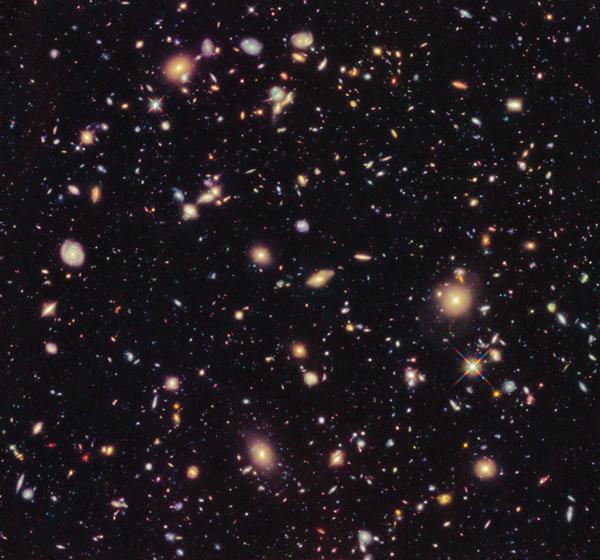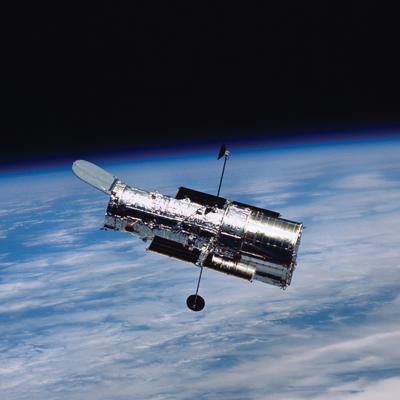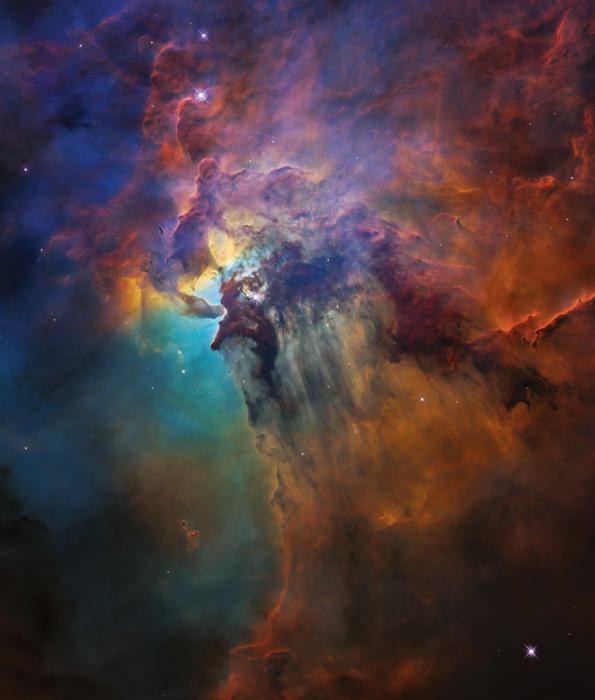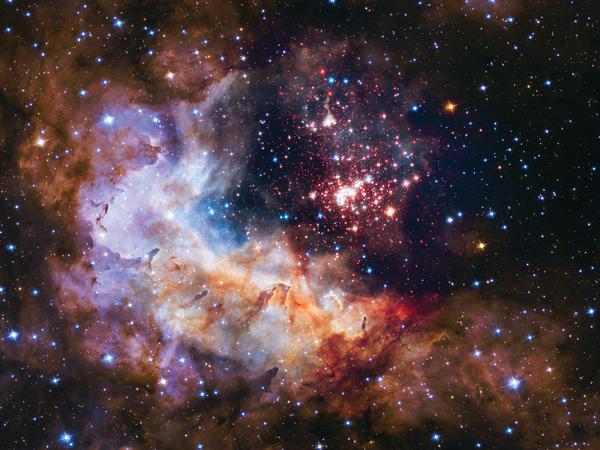- March 25, 2021
- By Chris Carroll
The idea behind the Hubble Space Telescope was simple, and brilliant.
Loft an observatory above the Earth’s atmosphere, where it wouldn’t need to squint through haze or the light pollution brought on by spreading urbanization. In orbit, it could see galaxies so distant that the light now reaching Earth began its journey soon after the Big Bang, and peer into cloudy regions of space for a front-row seat to the birth and death of stars—an entirely new way to view the universe.
Since Hubble’s 1990 launch, dozens of University of Maryland graduates have joined the mission, from flight control operations to communication of its discoveries to the public. They’ve played crucial roles in planning and executing sometimes dramatic space shuttle missions to upgrade its capabilities or repair the aging spacecraft’s components.
While Hubble has realized its promise and become one of the great triumphs of NASA’s history, space telescopes have a downside, too: Whatever needs to be done, there’s no easy way to reach it.
Now that the shuttle is only a memory and servicing missions have stopped, the approximately 20 Terps working on the Hubble mission at Goddard Space Flight Center—more than 20% of the total—are key in the effort to find innovative ways to keep Hubble operational long beyond the planned launch late this year of its successor, the James Webb Space Telescope.
Here are a few of their stories.
CLAIRE ANDREOLI ’14
 On April 24, 1990, the space shuttle Discovery opened its cargo bay doors and gently sent the Hubble Space Telescope into orbit. About three months later and 340 miles below, Claire Saravia Andreoli ’14 was born.
On April 24, 1990, the space shuttle Discovery opened its cargo bay doors and gently sent the Hubble Space Telescope into orbit. About three months later and 340 miles below, Claire Saravia Andreoli ’14 was born.
“I’ve never lived in a world where Hubble images didn’t exist, and where our view of the universe wasn’t shaped in some way by this mission,” said the journalism and biological sciences double major, today a NASA Astrophysics Division public affairs officer and communication lead for Hubble.
Andreoli works with writers, photographers, filmmakers and animators to tell the story of the space telescope and the staff carrying out the historic mission, making sure it isn’t lost in the shuffle of NASA news about solar satellites, trips to asteroids or a return to the moon.
“There’s always something new and exciting coming out of the agency, but we on the Hubble team want people to know it’s not just still alive,” she said. “It’s alive and well and producing important science.”
PATRICK CROUSE ’90, M.S. ’94
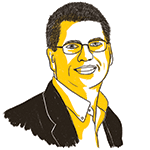 After a mere decade as the Hubble Space Telescope operations project manager, engineering alum Pat Crouse jokes he’s still the new kid on the block—at least compared to numerous colleagues who have been working with the telescope since launch.
After a mere decade as the Hubble Space Telescope operations project manager, engineering alum Pat Crouse jokes he’s still the new kid on the block—at least compared to numerous colleagues who have been working with the telescope since launch.
The uniqueness of Hubble, both as a crucial science instrument and as a sentimental touchstone, was driven home early in his tenure when an important component for telescope positioning began failing. As the head of the mission, it was his responsibility to order its shutdown and a backup unit turned on. As he prepared to carry out the decision that could have a fundamental effect on the telescope’s future, more experienced subordinates advised him to take it slow. “It was like, ‘Sure you want to do that without talking to anyone?’”
So he “socialized” the issue through successively higher echelons of management at Goddard and then at NASA headquarters and finally ended up in a meeting with top administrators—who approved his decision. “That was when it really hit me how much people at NASA really care about Hubble,” he said.
DAVE MURPHY ’89
 The Hubble is a telescope, but it’s also a spacecraft hurtling around the planet at 17,000 mph. Keeping its eye trained steadily on a nebula, cluster of distant galaxies or an exotic deep space discovery is the job of Dave Murphy, a UMD aerospace engineering grad who today is the lead pointing control systems engineer.
The Hubble is a telescope, but it’s also a spacecraft hurtling around the planet at 17,000 mph. Keeping its eye trained steadily on a nebula, cluster of distant galaxies or an exotic deep space discovery is the job of Dave Murphy, a UMD aerospace engineering grad who today is the lead pointing control systems engineer.
“Our pointing, when we’re doing science, has been compared to being in D.C. and aiming at a dime in New York, and staying focused on Eisenhower’s head,” he said.
Hubble’s six gyroscopes, of which three have failed, are key to positioning the telescope; keeping the remaining ones functional is at the core of Murphy’s responsibilities. They’re of a newer, more reliable type installed in the final Hubble servicing mission in 2009 (approved by Terp and then-NASA Administrator Michael D. Griffin Ph.D. ‘77), and could potentially help the telescope stay fully operational for another decade or more. Even if another gyro dies, the engineering team has developed a way to keep making observations at slightly reduced efficiency.
Murphy has worked on Hubble, and only Hubble, since graduation, and says he’d be happy to close out his career in the 2030s wringing every bit of usefulness from the aging spacecraft—which will have unmatched observational capabilities in the visual and ultraviolet spectrums for years to come.
“Finding the insight and the inspiration to allow Hubble to continue to do science even with hardware that’s getting old or beginning to fail may not be the most exciting work at NASA, but it’s very rewarding,” he said.
STEPHANIE CLARK ’10
 Teaching kids about Hubble, and potentially energizing the next generation of space explorers, is kinesiology graduate Stephanie Clark’s part in the Hubble mission.
Teaching kids about Hubble, and potentially energizing the next generation of space explorers, is kinesiology graduate Stephanie Clark’s part in the Hubble mission.
“You see everything from their jaws dropping at what they just learned is up in space, to the kids who want to tell you all about what they know,” she said.
The versatile communications specialist also creates social media content and gives presentations at various events.
“People seem to think you can only get a job at NASA if you’re a scientist or an engineer,” she said. “Actually, you can like writing, you can like teaching people things, you can like graphic design. There are so many jobs that contribute to the mission.”
SUZANNE BENEDICT ’87
 If Hubble had a test pilot, it might be Suzanne Benedict. The senior software engineer started more than 20 years ago as a Hubble flight controller, and today works in the flight software lab—a facsimile of Hubble’s onboard telescope control unit—creating case scenarios and seeing how new control software handles them before uploading it to the real spacecraft.
If Hubble had a test pilot, it might be Suzanne Benedict. The senior software engineer started more than 20 years ago as a Hubble flight controller, and today works in the flight software lab—a facsimile of Hubble’s onboard telescope control unit—creating case scenarios and seeing how new control software handles them before uploading it to the real spacecraft.
In the testing, Benedict is not exactly buzzing the tower “Top Gun”-style, but said, “We want to take it to the limit to know how far you can go and still be safe.”
As a criminal justice major who later went on to get a master’s in forensic science from George Washington University, Benedict dreamed of a job more “CSI” than “Star Trek”—death scene investigator—spurring jokes about how she could step in if the Hubble mission ever has an Agatha Christie-style murder mystery.
When she left NASA for a series of unsatisfying criminal justice jobs, she was drawn back by an environment that—while heavy on physics and engineering—values different backgrounds and novel approaches to solving problems. “Forensics doesn’t seem to want me, but Hubble has always kept me around,” she said.
STEVE ARSLANIAN ’89
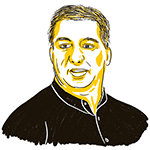 An unexpectedly quiet sun is providing Hubble with an extended lease on life. According to previous calculations, drag created by solar activity at the far reaches of the atmosphere was expected to end Hubble’s mission by the mid-2020s, but revised calculations show that it could stay aloft into the 2040s.
An unexpectedly quiet sun is providing Hubble with an extended lease on life. According to previous calculations, drag created by solar activity at the far reaches of the atmosphere was expected to end Hubble’s mission by the mid-2020s, but revised calculations show that it could stay aloft into the 2040s.
“We realized, ‘Hey, the Hubble is going to last a lot longer than we thought it would,’” said Steve Arslanian, a payload system engineer and mathematics graduate who became part of the Hubble mission crew just over a year after graduation, and never left. He’s since spent much of his career helping to design and build Hubble instruments like the Advanced Camera for Surveys, responsible for some of the telescope’s most stunning images, and then supervising the instruments’ operations in orbit.
“The idea now is to just make the Hubble last as long as possible,” Arslanian said. “Part of that is making sure we don’t wear out any of our critical components by overusing them.”
RUSS WERNETH ’64, M.S. ’68
 Hubble remains as capable as ever in large part to the five servicing missions conducted by space shuttle astronauts between 1993 and 2009. The astronauts in turn learned how to work on Hubble from Russ Werneth, Goddard’s lead for extravehicular activities, aka space walks.
Hubble remains as capable as ever in large part to the five servicing missions conducted by space shuttle astronauts between 1993 and 2009. The astronauts in turn learned how to work on Hubble from Russ Werneth, Goddard’s lead for extravehicular activities, aka space walks.
Werneth earned his degrees in mechanical engineering at UMD and joined the Hubble mission mid-career. From the moment the telescope first opened its eye in space in 1990, his hands were full. “Everything seemed to go well up to that point, but when we got the first images back, the scientists and engineers realized there was something wrong—really wrong.”
Hubble’s primary mirror had been formed incorrectly—it was off by 1/50th the diameter of a human hair around its outside edge, enough to render its images blurry. Replacing the massive mirror was impossible, so engineers instead devised a novel optical workaround, and Werneth’s team designed the tools and procedures to install it, including some underwater testing at UMD’s Neutral Buoyancy Research Facility, the largest such facility at any university.
Astronauts in 1993 were able to effect a fix in orbit. “It saved the mission,” Werneth said. “Some think it saved NASA.”
After training astronauts for several more servicing missions, he retired in 2007, returned for the final 2009 servicing, and today does outreach for the Hubble mission—calling himself and other enthusiasts “Hubble Huggers.”
Although the shuttle is retired, one final Hubble mission likely remains (although NASA says no final decisions have been made about the end of the Hubble mission).
“At the end of its life, when it can’t do useful science anymore, we will send a robotic vehicle to Hubble that will attach to a plate that we installed on the bottom,” Werneth said. “It will guide the Hubble into the ocean safely, and most of it will burn up on the way down. It will be a sad day for those of us Hubble Huggers—hopefully it doesn’t come too soon.”
